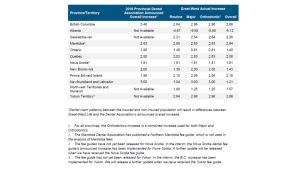Employee benefit plan sponsors will note that with each renewal, their Provider will assign a trend/inflation increase to their dental renewal rates for the upcoming period. Dental trend is broken down into two components; one being utilization, whereby there is an expectation of increased usage of the plan as members become more aware of their dental benefits and suppliers become more aggressive with respect to their call back and appointment setting practices. Insurers routinely apply utilization figures of between 4% and 5% annually. The second component of trend is the Provincial fee guide, which increases each January. This is a recommended fee guide and dentist are free to deviate from this guideline based on the economics of their own practice. Insurers pay reasonable and customary fees, so there is an allowance for fees above the suggested schedule. Excessive billings however, would be cut back, forcing this additional cost back to the plan member or back to the dentist; who would have to absorb the additional charges, above the reasonable and customary limits.
It is important to note that the annualized adjustment is not applied evenly to every procedure code. In fact various procedure codes will have different levels of increase. To illustrate this fact, we have outlined the increases by category from Great West Life to demonstrate how the adjustments are applied.
Each Provincial dental association, now including Alberta, publishes an annual fee guide. Dentists use these guides for reference when determining their own fees for the year ahead. It should be noted that Great-West Life and we would suspect all Insurers, set their overall dental claim cost increases by comparing fee increases in these Provincial guides with the most commonly used procedure codes from the previous year.
Effective January 1, 2018, the Alberta Dental Association also publishes a Provincial dental specialist fee guide. As a result, the 20 per cent reimbursement benchmark added for general practitioners and used in previous years no longer applies.
Please review the table below for the adjustments by Province and by dental category:

